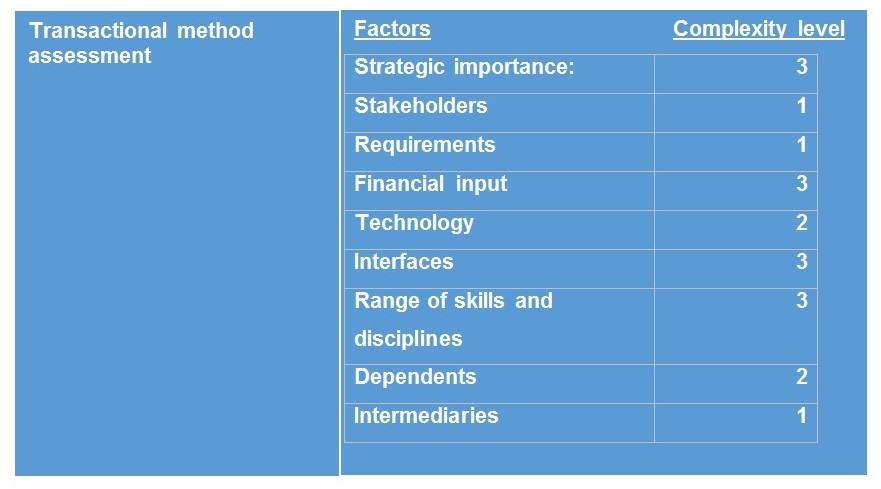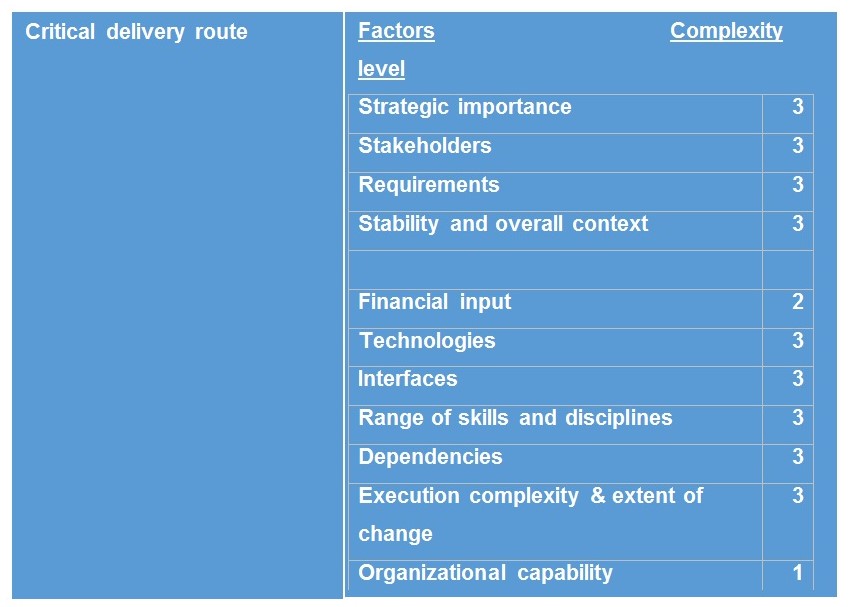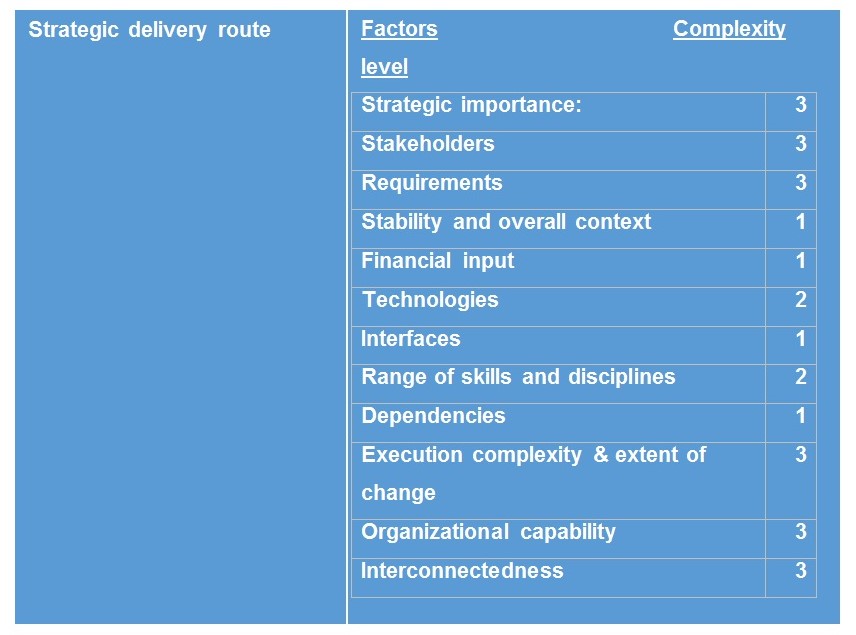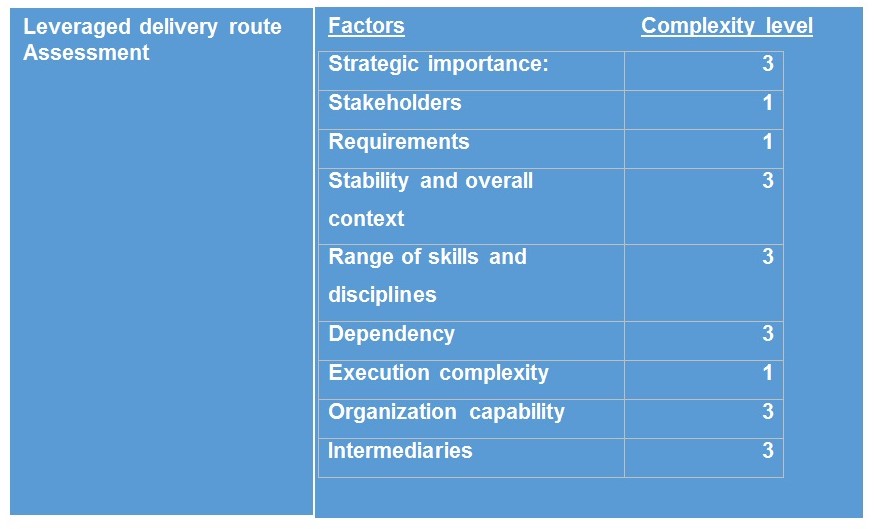Introduction
Large infrastructure projects are considered risky and costly. It is estimated that up to 90% of large infrastructure projects usually result in overrun costs averaging 28% higher than budget according to Flyvbjerg et al. (2014). This trend is common in Europe, and the UK, in particular, does not compare too well with its European peers.
There are two main assessment tools proposed by HM Treasury (2012) for the assessment and selection of the final delivery route for a large infrastructure project. These tools identify implementation barriers after a successful complexity and capability assessment. They include delivery route screening and functional assessment. Delivery route screening involves selection of the appropriate procurement approach for complex projects to align it with strategic models of high capacity than critical and transactional approaches (Weber et al. 2016; Alfen & Staub-Bisang 2016). The ideal achievement of delivery route screening is to assign tasks based on client’s capability and type of challenge to achieve maximum benefit with the support of an appropriately endowed sponsor with oversight ability. On the other hand, functional assessment entails an evaluation of the client and supply chain capability, functional arrangement and the requirement for enhancing the capability to resolve challenges that are identified in the complexity assessments (Treasury, 2016, p.22; Treasury, 2013). These two tools allow the determination of the appropriate delivery route that maximises value.
Transactional methods
Transactional methods and procedures are guaranteed either to be functional or not to function at all. The transactional model emphasises on setting goals, creating efficiency and identifying the number of risks beyond the client/contractor interface. Its basis is the deployment of a quality functional to the design of a procurement system. This method emphasises that many risks involved in large projects are both foreseeable and avoidable when the right measures are in place (Irimia-Diéguez, Sanchez-Cazorla, & Alfalla-Luque, 2014, p.410). Most of the risks that evolve into major problems are caused by a failure in the professionalism and failure to look forward to managing risks. In this method, the analysis of processes and events surrounding a transaction are considered crucial to informing the theory of a procurement system since a transaction is considered a unit of economic activity (Jelodar, Yiu, & Wilkinson, 2016). Two main strategies exist in this method. They include information management and asset specificity. In a project setting, information is essential for the formation of contracts, coordinating different parties’ inputs and outputs and economic control. Information is the backbone uncertainty management (Veerweij; Batel, & Devine-Wright 2015). With complex projects, the need for information processing increases.
The route selection extends beyond the simple contractor-client interface; such a model takes into account the contingency facts influencing structuring of project teams (McNeil, 2014). Moreover, it enables an information-based monitoring of the physical and financial performance of selected teams. The availability of information dictates largely the ability to control design impacts and changes in the production. A transaction model looks to address three main problems. First, it is common that project descriptions fail to identify their requirements and constraints precisely. Secondly, assessment of procurement approaches lags due to inadequacy in assessment frameworks. Finally, it is difficult to develop comparisons from the bespoke contracts nature (Savacool et al. 2017).
The quality function deployment (QFD) framework is commonly used for transactional management method. The framework allows decision makers to consider interdependencies between the project and procurement (Cantarelli, & Flyvbjerg, 2015; Kerzner, 2013). There are four phases to the approach with the first being prioritising and definition of customer needs, analysis of opportunities and evaluating the interdependencies between needs to formulate and translate them into design attributes (Rahman, et al., 2013; Kendrick, 2015) The second phase involves the assembly of the critical procurement system components identified for deployment to achieve critical target outcome. In phase three, involves critical process parameters are identification and determination of critical processes and flows through planning (Burke et al., 2015; Ansar, et al., 2016). The final phase aims to establish inspection, tests methods and parameters for quality control. It also establishes process control methods and determines the critical project component and process characteristics.
Complexity analysis

The transactional method emphasises the strategic importance of the project due to the expected impacts failure (Brady, 2014, p.26). The setting of quality standards early on to mitigate failure portrays this criterion and is a vital element for the success of a large project. Public infrastructure projects have big impacts if they fail. On the other hand, the strategy emphasises on a low number of stakeholders by advocating for efficiency thus reducing complexity. The Hong Kong airport opening delay resulted from a lag in the way the delivery lacked key performance indicators and goals required in a transactional model (McNeill, 2014, p.2996; Ansar, et al., 2014). It resulted in a loss of 600 million dollars. However, the transactional model is not very well placed to allow flexible implementation and therefore, it still might have resulted in some other forms of losses. The London 2012 Olympics’ Olympic Delivery Authority (ODA) successfully created a consortium comprised of CH2M, Laing O’Rourke and Mace to evaluate risks and set goals (Davies & Mackenzie, 2014, p.775).
Leveraged methods
Leveraged methods are supplemented with various mechanisms to manage risk. Good practices involve proper controls to avoid schedule overruns and cost overflows involving assignment a team to the project early and assigning members to the team early enough. Assigning a permanent team to a project to handle the whole life cycle is better than a continuous change in personnel assigned to the various stages of the project (Beckers, et al., 2013, p.146). This practice does not only promote accountability and transparency but also enhance responsibility throughout the whole management life cycle. After a project is authorised, there is little flexibility left in planning and organisation (Guo, Chang-Richards, Wilkinson, & Li, 2014). Flexibility virtually disappears once machinery, materials and workforce appear on the site and costs start building up. Key personnel to oversee a project should include a project coordinator or director, an engineering manager, a construction manager, a procurement manager and a commissioning and start-up manager. Among other leading practices, adhering to this requirement mitigates and eliminates many risks associated with megaproject (Verweij, 2014, p.36). It is about being smart on the project delivery and the contracting strategies.
The second vital practice is having a good choice for the project delivery strategy. A delivery strategy has far-reaching implications and is a core driver for the overall project costs, the schedule and quality of design. Moreover, a delivery strategy influences the approach for construction and long-term demands maintenance (Kelly, 2014, p.13). A range of project delivery strategies exist. They range from the construction owner having full participation in project management and implementation to the situation where minimal input comes from the owner. In the second case, a contractor coordinates all aspects of the project (Pollack, & Algeo, 2015; Fellows, & Liu, 2015). There are four main categories of delivery strategies, which apply to large projects. They include the traditional, collaborative, integrative and partnership strategies. The traditional approach has little interest on the tying factor and involves designing, bidding and building. In the integrative approach, the project sponsor, financier, designer and contractor make decisions to ensure the best interests of the project as stakeholders (Beckers, et al., 2013, p.146).
Complexity analysis
The leveraged delivery route has several positive attributes that include well-aligned stakeholders, integration of benchmark standards and support, scores of skills and disciplines, and simplified execution. However, several demerits arise from the model such as too much dependency on the outcomes of other projects and benchmarked experiences. The London Cross Rail successfully employed this technique to deliver on time and on budget. The model used in the delivery of the London 2012 Olympics stadium was largely the basis for the project execution. Also, the director of Heathrow Terminal 5 was picked to assist in execution (Davies & Mackenzie, 2014, p.780).
Critical methods
Critical methods are those methods characterised by careful consideration and judgment with a continuous call to attention and flaws. A collaborative strategy calls for an ongoing feedback loop from experts in the field before design completion to factor in all risks. Finally, governmental agencies collaborate with private companies through public- private partnership to deliver projects without the usual public agency outlays (Pollak, p.22; Van Wee, & Priemus, 2016). The desire to control any number of aspects of a project drives the need for a project sponsor to select the appropriate delivery strategy. For instance, a project sponsor with a good in-house engineering department may prepare the process and designs for other people to implement. Other owners might be interested in purchasing the majority of equipment and items to control materials costs. A functional assessment evaluates the capabilities that are assignable to such project owners (Walker, 2015, p.50; Irimia-Diéguez, Sanchez-Cazorla, & Alfalla-Luque, 2014,). The objectives of owner or sponsor, speed to market, resources, expectations of quality and costs as well as the contractor’s capabilities and risk appetite should guide the project delivery method selected.
Preliminary studies that produce a design basis should go hand in hand with the project’s feasibility stage. Such estimates ought to include all factors ranging from prices of commodities, project management costs, engineering quantities, craft and supporting labour laws and costs associated with internal company operations. Such costs include management time, shared services, financing costs and other costs resulting from engineering and procurement resources (Hartmann, et al., 2012). It is important to factor in inflation and price escalation for equipment, labour and commodities if the length of project introduces such a risk. A proper pre-execution planning is all about modelling the risk profile to a state that is manageable during the implementation phase of the project, while execution proactively mitigates the risks emerging throughout the life cycle. The plan should verify inherent risks and the degree of freedom allowed to shape the risk profile before funds commitment and having skills in place to ensure risks do not spill out of control (Savacool, 2017, p.127; Pryke, & Smyth, 2012).
An inherent conflict persists in the bid to maintain maximum flexibility to enable ease of response to unforeseen changes during the entire life cycle of a project, and desire to limit the frequency and volatility of risks that may arise (Erkul, et al., 2016, p.704). An end-to-end view of risk management is vital because these risks can manifest at later project stages while different responsibilities in the earlier stages of the project caused them. Individualised process-step responsibilities are unsuitable for such a task. Moreover, a proactive and continuous approach to risk mitigation is most attractive through the entire life cycle. A project team should embark on the determination of how significant risks influence the costs and opportunities using quantitative and qualitative cost risk analysis (Ansar, 2016, p.43,). The Monte Carlo simulation is a quantitative probabilistic technique for evaluation of reasonable risk amount contingency to be carried out in the budget. Also, the realistic completion date should be analysed through a quantitative schedule risk analysis.
Complexity analysis

The critical delivery route is probably the most complex of the four methods deliberated in this paper. The strategy is based on a long-term and continuous feedback loop and elimination of rigidity in the decision-making. The major drawbacks apart from the complexity are the unpredictable governance structure and the requirement for a large pool of skills. There is also high uncertainty to the requirements definition. However, it presents the most technologically adapted delivery route despite being expensive (Williams, Ashill, Naumann, & Jackson, 2015; Waage, et al., 2015). A mega project that successfully employed this technique was the Heathrow Terminal 5 expansion. The delivery team realised that taking away risk from the supply chain as is the norm for large projects would eliminate the need for over budgeting and delivery challenges. A critical approach that eliminated traditional rigidity was used, whereby a collaborative, innovative and flexible supply chain mitigated and accommodated risks over the entire life cycle. The project was delivered on time and in the budget (Cizaire & Valerdi, 2014, p. 731,742).
Strategic methods
Because of the complex nature of large infrastructure projects, there are multiple stakeholders involved in their delivery including sponsors, regulators, financiers, government officials and a wide range of contractors as well as affected parties. Each of these parties has their obligations, roles and responsibilities and their response to particular incentives is a contributor to the overall risk management (Zou et al., 2014, p.267). When each party controls aspects of the project within its area of competitive advantage, there are emergent processes that originate from the interactions between multiple components over time. A strategic method or methods will look to implement a governance structure that integrates all the parties involved and the control processes to lead to adaptation rather than runaway risks. Such strategies could involve joint alliances and partnerships. It is common for alliances and partnerships to every large project.
Importantly, strategic backing from senior management or officials is crucial for the success of any large project. When senior management buys into the mega project, some risks that might cause the project to fail are mitigated (Giezen, 2012, p.781, 783). A complete project charter and project execution plan must precede the approval of a project. Further, a baseline budget and a schedule prepared and vetted by a project team are crucial. It is critical that visualisations of cash-flow models, financial analysis and funding methods are visible on paper. Moreover, when a project is in line with the goals of the government or institution, it is considered the best use for money. Finally, a project sponsor appointed to report on progress, associated risks and challenges to senior officials assists in getting support to mitigate risks such as security and political risks that might stall the project resulting in cost overruns and stall or even failure (Treasury, 2016, p.13).
For a mega project to success, policies and procedures specific to the project are crucial. This success is dependent on a tight collaboration between the extended project stakeholders. They include the contracting party’s team, partners in a joint venture, financiers and lenders, insurance providers, suppliers, subcontractors, engineering department, procurement and the contractor themselves. For effective collaboration, a robust set of policies and procedures, definitive roles and responsibilities as well as clear and frequent communication are vital. The best practice the world over is to set up a team to tailor-make the policies, guidelines and procedures necessary meet the unique needs of a mega project. Such policies should be deliberate the needs without influence from the existing policies, guidelines and procedures (Kivilä, Martinsuo, & Vuorinen, 2017). Experience and technology alone are not sufficient for project managers to manage large projects successfully (Beckers, et al., 2013, p. 23; Ahola, et. al., 2014). Thoughtful and deliberate use of controls put in place when planning and organising the project early on increases the probability of project success.
Complexity analysis

The strategic delivery route has defined interfaces, and the overall stability is good due to prioritisation and harmonisation of stakeholder interests. Also, the execution is accommodative to change and handles interconnectedness well. However, the integration of multiple interests means that the requirements may compromise to appease all parties involved. The strategic importance means that there may be unnecessary politics and attention, which if not managed well poses a risk. When Airbus undertook to expand is plant, the strategic route was chosen to ensure delivery on time and budget. The project organisation involved employing a steering committee appointed by the stakeholders. Each stakeholder conducted a risk assessment and adoption, and they all agreed on a choice of the project manager in a model that accommodated both formal and informal reporting on the progress (Burns, 2016, p.194; Hertogh, et al., 2012.).
Conclusion
According to infrastructure costs reviews by HM Treasury and Infrastructure UK (2012), the costs for construction and maintenance in the UK are significantly higher than in other European projects e.g. in high-speed rail links (Burger, 2012, p.91). In this case, the cost of constructions could be controlled based on the delivery route adopted by the construction team.
References
Ahola, T, Ruuska, I, Artto, K & Kujala, J 2014, What is project governance and what are its origins? International Journal of Project Management, vol. 32, no. 8, pp.1321-1332.
Ansar, A, Flyvbjerg, B, Budzier, A & Lunn, D 2016, Big Is Fragile. The Oxford Handbook of Megaproject Management, p.60.
Ansar, A, Flyvbjerg, B, Budzier, A & Lunn, D 2014, Should we build more large dams? The actual costs of hydropower megaproject development. Energy Policy, vol. 69, pp.43-56.
Batel, S & Devine-Wright, P 2015, A critical and empirical analysis of the national-local ‘gap’in public responses to large-scale energy infrastructures. Journal of Environmental Planning and Management, 58(6), pp.1076-1095.
Beckers, F, Chiara, N, Flesch, A, Maly, J, Silva, E & Stegemann, U 2013, A risk-management approach to a successful infrastructure project (No. 52, p. 146). McKinsey Working Papers on Risk.
Brady, T & Davies, A 2014, Managing structural and dynamic complexity: A tale of two projects. Project Management Journal, vol. 45, no. 4, pp.21-38.
Burke, R & Demirag, I 2015, Changing perceptions on PPP games: Demand risk in Irish roads. Critical Perspectives on Accounting, vol. 27, pp.189-208.
Burger, P & Hawkesworth, I 2012, How to attain value for money: comparing PPP and traditional infrastructure public procurement. OECD Journal on Budgeting, vol. 11, no. 1, p.91.
Burns, R 2016, Megaproject Escalation of Commitment. The Oxford Handbook of Megaproject Management, p.194.
Cantarelli, CC & Flyvbjerg, B 2015, Decision making and major transport infrastructure projects: The role of project ownership.
Cizaire, C & Valerdi, R 2014, Heathrow Terminal 5: Cost Management for a Mega Construction Project. In Case Studies in System of Systems, Enterprise Systems, and Complex Systems Engineering (pp. 731-749). CRC Press.
Davies, A & Mackenzie, I 2014, Project complexity and systems integration: Constructing the London 2012 Olympics and Paralympics Games. International journal of project management, vol. 32, no. 5, pp.773-790.
Erkul, M, Yitmen, I & Çelik, T 2016, Stakeholder Engagement in Mega Transport Infrastructure Projects. Procedia Engineering, vol. 161, pp.704-710.
Fellows, RF & Liu, AM 2015, Research methods for construction. John Wiley & Sons.
Flyvbjerg, B 2014, What you should know about megaprojects and why: An overview. Project Management Journal, vol. 45, no. 2, pp.6-19.
Giezen, M 2012, Keeping it simple? A case study into the advantages and disadvantages of reducing complexity in mega project planning. International Journal of Project Management, vol. 30, no. 7, pp.781-790.
Guo, F, Chang-Richards, Y, Wilkinson, S & Li, TC 2014, Effects of project governance structures on the management of risks in major infrastructure projects: A comparative analysis. International Journal of Project Management, vol. 32, no. 5, pp.815-826.
Hartmann, T, Van Meerveld, H, Vossebeld, N & Adriaanse, A 2012, Aligning building information model tools and construction management methods. Automation in construction, vol. 22, pp.605-613.
Hertogh, MJ, Baker, S, Staal-Ong, PL & Westerveld, E 2012, Managing large infrastructure projects: Research on best practices and lessons learnt in large infrastructure projects in Europe. Drukkerij Hooiberg.
Irimia-Diéguez, AI, Sanchez-Cazorla, A & Alfalla-Luque, R 2014, Risk management in megaprojects. Procedia-Social and Behavioral Sciences, vol. 119, pp.407-416
Jelodar, MB, Yiu, TW & Wilkinson, S 2016, A conceptualisation of relationship quality in construction procurement. International Journal of Project Management, vol. 34, no. 6, pp.997-1011.
Kelly, J, Male, S & Graham, D 2014, Value management of construction projects. John Wiley & Sons.
Kendrick, T, 2015, Identifying and managing project risk: essential tools for failure-proofing your project. AMACOM Div American Mgmt Assn.
Kerzner, H, 2013, Project management: a systems approach to planning, scheduling, and controlling. John Wiley & Sons.
Kivilä, J, Martinsuo, M, & Vuorinen, L 2017, Sustainable project management through project control in infrastructure projects. International Journal of Project Management.
McNeill, D 2014, Airports and territorial restructuring: The case of Hong Kong. Urban Studies, vol. 51, no. 14, pp.2996-3010.
Pollack, J & Algeo, C 2015, The contribution of project management and change management to project success. The Business & Management Review, vol. 6, no. 2, p.22.
Pryke, S & Smyth, H 2012, The management of complex projects: A relationship approach. John Wiley & Sons.
Rahman, AI, Memon, AH, Karim, A & Tarmizi, A 2013, Significant factors causing cost overruns in large construction projects in Malaysia. Journal of Applied Science, vol. 13, no. 2, pp.286-293.
Savacool, BK, Proudlove, A & Green, N 2017, Scale, Risk, and Construction Cost Overruns for Electricity Infrastructure. The Governance of Infrastructure, p.127.
Treasury, HMS 2012, The Green Book-Appraisal and Evaluation in Central Government. TSO: London.
Treasury, H.M.S., 2012. A New Approach to Public Private Partnerships. TSO: London, Web.
Treasury, HMS 2013, Early Financial Cost Estimates of Infrastructure Programmes & Projects and the Treatment of Uncertainty & Risk. TSO: London, Web.
Treasury, HMS 2012, HS2 Cost & Risk Model Report. TSO: London, Web.
Treasury, HMS 2013, The Strategic Case for HS2. TSO: London, Web.
The Infrastructure Risk Group 2013, Managing Costs and Uncertainty in Infrastructure Projects. The Institute of Risk Management, Web.
Treasury, HMS 2012, Infrastructure Cost Review. TSO: London, Web.
Treasury, HMS 2016, Asset Management Module – Improving Infrastructure Delivery: Project Initiation Route map. TSO: London, Web.
Van Wee, B & Priemus, H 2016, Megaproject Decision Making and Management. The Oxford Handbook of Megaproject Management, p.118.
Verweij, S & Gerrits, L 2014, Managing unplanned events in large infrastructure projects: Results from an in-depth comparative case evaluation.
Waage, J et al. 2015, Governing the UN Sustainable Development Goals: interactions, infrastructures, and institutions. The Lancet Global Health, vol. 3, no. 5, pp.e251-e252.
Walker, A 2015, Project management in construction. John Wiley & Sons.
Weber, B, Alfen, HW & Staub-Bisang, M 2016, Infrastructure as an asset class: investment strategy, sustainability, project finance and PPP. John wiley & sons.
Williams, P, Ashill, NJ, Naumann, E & Jackson, E 2015, Relationship quality and satisfaction: Customer-perceived success factors for on-time projects. International Journal of Project Management, vol. 33, no. 8, pp.1836-1850.
Zou, W, Kumaraswamy, M, Chung, J, & Wong, J 2014, Identifying the critical success factors for relationship management in PPP projects. International Journal of Project Management, vol. 32, no. 2, pp.265-274.
